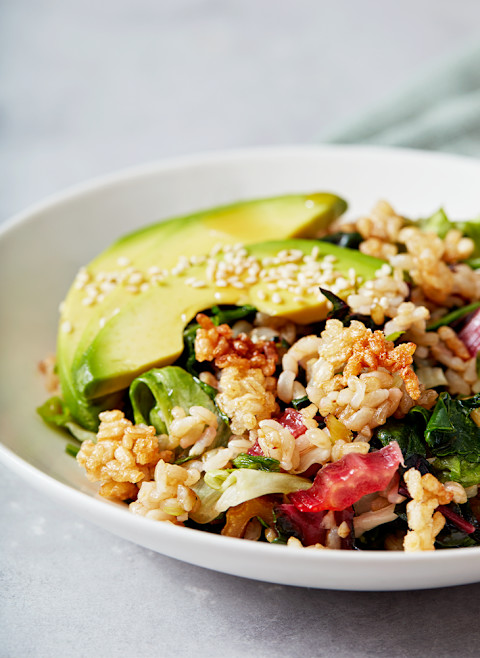How To Eat Better, Feel Better & The Recipes That Get You There

At mbg, we believe that nutritious and delicious food has the power to fuel both health and happiness. Like you, we're passionate about embracing healthy eating as an evolving lifestyle—meaning we're always looking for ways to spice it up. Giada De Laurentiis's new book, Eat Better, Feel Better breathes fresh inspiration into our diets by teaching us how to choose (and cook) the foods that simply make us feel better. It never ceases to amaze us how less inflammation and higher quality of life often come down to what's on our plate. With a three-day reboot program, wellness routines like meditation, and 100-plus Italian-influenced recipes (looking at you, Chocolate and Orange Brown Rice Treats), Giada's book gives us all the tools we could need for eating well and feeling our best.
To get a (literal) taste of Eat Better, Feel Better, check out the excerpt and recipe below. Enjoy Giada's other recipes and self-care guidance by purchasing your own copy here.
Eat Better, Feel Better
My new book is the culmination of a 10-year journey, an exploration that not so coincidentally took place between my 40th and 50th birthdays. Over the last decade, I've made a conscious effort to take control of my health because it had finally become impossible to ignore the fact that the choices (or lack thereof) I'd been making for the past 20 years just weren't working for me anymore.
A lot of factors brought me to this point. My 40s were an incredible career-building period: I opened three restaurants and launched a website and e-commerce business, all while shooting multiple cooking shows in LA, NYC, and Italy and raising a daughter as a single mom. It seemed the harder I worked, the more opportunities I was offered, and I didn't want to let any of them slip away. I was chronically sleep-deprived, and a couple of minutes on a hotel treadmill were as close as I came to an exercise routine. Some days I barely ate enough to keep me going. I was finally attaining the kind of success I'd never even dreamed of, but a lot of the time I was too depleted to enjoy it.
Stress was omnipresent. Bloating, frequent stomach pains, gas, and acid reflux were everyday events. Some days I simply felt overwhelmed, but I just chalked it up to being overworked. I was foggy, irritable, tired, and weak, and I didn't have the resilience to fight off even the mildest of colds that might be going around. I realized that if I didn't prioritize my health above the hundred other things vying for my attention, I would only continue to feel worse, not better.
And let's not forget, as a woman, knocking on the door of 50 brings its own special challenges. Along with the wisdom of experience and a newfound confidence come the joys of a slower metabolism, hormonal fluctuations, and a host of physical changes, from loss of muscle mass to deepening crow's feet and wrinkles. And it's not only those of us who spend many of our days with a camera pointed in our direction who struggle with these changes; everyone wants to look and feel their best.
So, I made changes to the way I eat—big ones. I came up with a program that gave my digestive system a chance to recover and heal and an approach to eating that let my body work a little less hard at processing what I ate so it could spend more of its resources on keeping me healthy and active.
And when I think my digestion needs a reboot—either because I've been too careless about what I'm eating or traveling a lot and eating on an unpredictable schedule, I use a quick reboot plan to get everything back on track. This means giving my gut as much of a break from low-grade inflammation as I possibly can and eating even cleaner and lighter than usual.
Once I rethought the way I ate and how my body processes the fuel I feed it, it was easier to fit restorative practices like meditation, consistent exercise, and better sleep into my life.
In this book, I share the recipes and philosophy that I used—and continue to practice—to reset my digestive health, restore my gut's ability to work at peak capacity and keep my immune system strong. My approach minimizes foods known to cause inflammation and nurtures the delicate ecosystem of the gut rather than stressing it out with toxins and irritants. And while this is not a weight-loss plan, I wouldn't be surprised if prioritizing some of these gut-friendly foods for a few weeks—or longer, if you like the way they make you feel—results in a corresponding de-emphasis on the foods that make you feel clogged up, bogged down, and heavy. If you eat well most of the time, you may also find that when you do stray (it happens to the best of us), recovery will become more intuitive and less depleting.
I'm not gonna lie; it's not easy to change the way you think about food, but I'm better for it every day, and you will be too. In Eat Better, Feel Better you'll find a wealth of flavorful and uncomplicated recipes that will help reset your gut; a quick, three-day reboot; 21 days of meal plans to help you make eating smarter a habit rather than a "diet," and all the lessons I've learned about what makes me feel stronger, healthier, and well fed, in both senses of the word.
Buon appetito—and buona salute!
Green Fried Rice
Serves 4
● 2 tablespoons olive oil
● 2 tablespoons dark sesame oil
● 1 bunch of scallions, chopped
● 2-inch piece of ginger root, peeled and finely chopped
● 1 garlic clove, coarsely chopped
● 2 teaspoons kosher salt
● 2 cups cooked brown rice (page 92, preferably leftover)
● 1 bunch of Swiss chard, stems chopped fine and leaves cut into 1-inch pieces
● 1 bunch of escarole, chopped into 1-inch pieces
● 3 cups baby kale, chopped
● 1 avocado, sliced
● Toasted sesame seeds, for garnish (optional)

Heat a large skillet over medium-high heat. Add the olive oil and 1 tablespoon of the sesame oil and heat for an additional minute. Add the scallions, ginger, garlic, and ½ teaspoon of the salt. Cook, stirring often, for about 2 minutes, until fragrant.
Add the rice and ½ teaspoon of the salt and toss to coat with the seasonings, then spread the mixture evenly over the bottom of the pan. Cook without stirring for 2 minutes. Using a wooden spoon, scrape the crispy rice from the bottom of the pan and stir well to distribute, then cook again without stirring for 2 minutes. Repeat these steps two more times to create layers of crispy, golden brown rice.
Add the Swiss chard stems and again cook without stirring for 2 minutes. Last, add the chard leaves, escarole, and kale along with the remaining tablespoon of sesame oil and 1 teaspoon salt. Stir in the greens a bit at a time; they will fit more easily as they wilt.
Cook until the greens are fully wilted and incorporated into the rice, 5 to 8 minutes. Serve topped with sliced avocado and, if desired, a sprinkling of toasted sesame seeds.
Giada De Laurentiis was the star of Everyday Italian on the Food Network. She attended Le Cordon Bleu culinary school in Paris and then worked in a variety of Los Angeles restaurants, including Wolfgang Puck's Spago, before starting her own catering and private-chef company, GDL Foods, whose clients have included such stars as Ron Howard. She is the granddaughter of movie producer Dino De Laurentiis and grew up in Los Angeles, where she still lives.
